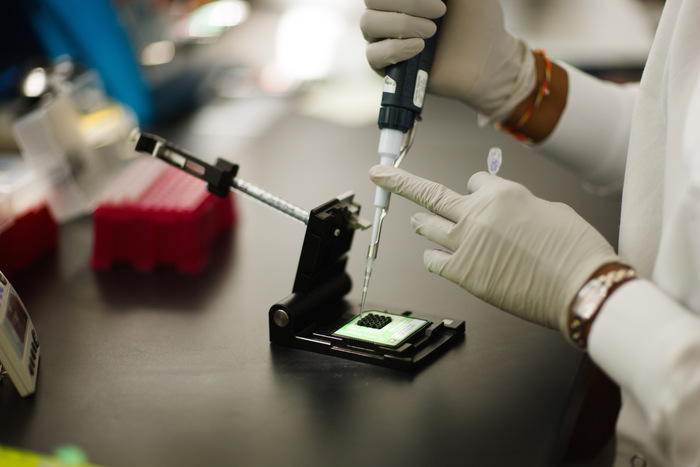LA JOLLA, CA—One of modern biologists’ most ambitious goals is to learn how to expand or otherwise modify the genetic code of life on Earth, in order to make new, artificial life forms. Part of the motivation for this “synthetic biology” research is to understand more about the evolution and the logic of the natural biology we’ve inherited. But there’s also a very practical motivation: Cells can be used as efficient factories for making a broad array of useful molecules—especially protein-based therapeutics, which account for an increasing share of new medicines. Cells working with an expanded genetic code could make a much more diverse set of such medicines and could do so in a way that greatly simplifies the overall process of developing and manufacturing them.

Credit: Scripps Research
LA JOLLA, CA—One of modern biologists’ most ambitious goals is to learn how to expand or otherwise modify the genetic code of life on Earth, in order to make new, artificial life forms. Part of the motivation for this “synthetic biology” research is to understand more about the evolution and the logic of the natural biology we’ve inherited. But there’s also a very practical motivation: Cells can be used as efficient factories for making a broad array of useful molecules—especially protein-based therapeutics, which account for an increasing share of new medicines. Cells working with an expanded genetic code could make a much more diverse set of such medicines and could do so in a way that greatly simplifies the overall process of developing and manufacturing them.
The realization of the grand goal of a working, useful synthetic biology is still some years off. But in a study published this week in Nature Communications, scientists have taken a significant step closer to it, by developing and demonstrating key components of an expanded genetic code system.
“We’ve supplemented the synthetic biology toolkit to streamline investigations into genetic code expansion,” says study senior author Ahmed Badran, PhD, an assistant professor in the Department of Chemistry at Scripps Research.
The natural genetic code underlying life on Earth is used by cells to translate information contained in DNA and RNA into the amino-acid building blocks of proteins. DNA and RNA molecules are chain-like molecules that encode information using an “alphabet” of four nucleotide building blocks, or “letters.” Molecules called transfer RNAs (tRNAs) decode this information by recognizing three letters at a time, translating each three-letter “codon” into a single amino-acid building block of a protein. This triplet codon system in principle can encode 64 different amino acids (43)—yet typically only 20 amino acids are used in most organisms.
By contrast, the envisioned quadruplet system, based on four-letter codons, could encode 256 (44) distinct amino acids. Obviously, most of those would not exist in natural proteins, although some could be slight variations on natural amino acids, enabling proteins to be made with much more finely tuned characteristics, for example to optimize their effectiveness and safety as medicines.
The enormous challenge here comes from the fact that the system of gene-to-protein translation is a complex one in which multiple components must work together smoothly. The system that exists in living organisms on Earth presumably took many millions of years to evolve to its present levels of accuracy and efficiency. Prior efforts to engineer whole new systems, including quadruplet-codon systems, have shown some promise in recent years.
In the new study, Badran and his team used an evolutionary, survival-of-the-fittest, technique called directed evolution to evolve a small set of tRNAs that in principle could work in a quadruplet system. The scientists showed that these quadruplet tRNAs could be used to translate segments of a protein within bacterial cells. They were able to translate six identical quadruplet codons after one another, and even translate four very different quadruplet codons in the same protein—and could do so at efficiencies that are for the first time within striking distance of what would be needed for a functional quadruplet system.
Badran emphasizes that although a quadruplet code system is still very much in the early, methods-development stage, it should be very useful if it can be made to work—especially in enabling the straightforward synthesis of proteins with “non-canonical” amino acids that aren’t found naturally in proteins. Such ncAAs, as they are called, could be used to give proteins novel biological properties, including the provision of convenient, safe “handles” on a protein—for the placing of chemical modifications to improve the protein’s therapeutic properties, for example, or for the attachment of a toxic “warhead” on a tumor-homing cancer drug.
“One could theoretically program a sequence of DNA that would be translated, in a living cell, into a protein that contains a complex set of modifications—modifications that otherwise would be difficult or impossible to add,” Badran says.
Badran, who joined Scripps Research earlier this year, worked at the Broad Institute of MIT and Harvard during the study.
In addition to Badran, the study, “Multiplex suppression of four quadruplet codons via tRNA directed evolution,” was co-authored by Erika DeBenedictis and Gavriela Carver, of the Broad Institute, and Christina Chung and Dieter Söll of Yale University.
###
Media contact: [email protected]
Journal
Nature Communications
DOI
10.1038/s41467-021-25948-y
Method of Research
Experimental study
Subject of Research
Cells
Article Title
Multiplex suppression of four quadruplet codons via tRNA directed evolution
Article Publication Date
29-Sep-2021
COI Statement
A.H.B., E.A.D, and G.D.C. have filed Provisional Patent Applications (No. 16/894,359, and assignment pending) through the Massachusetts Institute of Technology and the Broad Institute of MIT & Harvard on sequences and activities of tRNA variants described in this paper. The remaining authors declare no competing interests.




